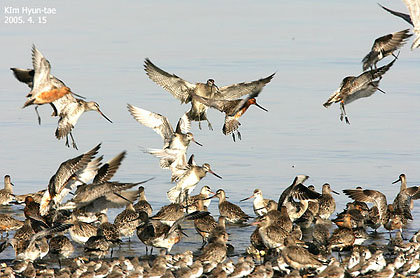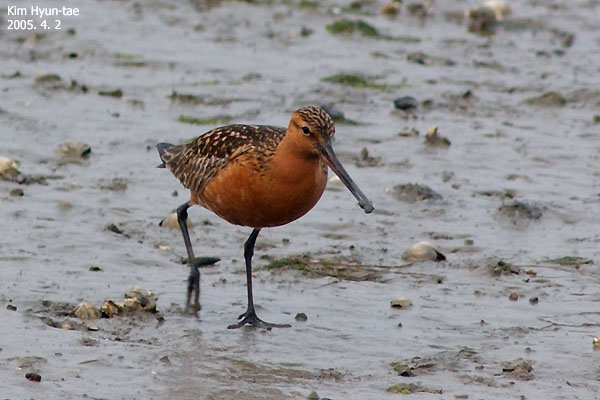The World's greatest migrant?

Spring is an excellent time to see shorebirds in Korea – many stunning in rich breeding plumage. Among the more widespread and obvious of these in April and May is the Bar-tailed Godwit Limosa lapponica - males intensely orangey-red below, females much grayer.
Beautiful to look at, a harbinger of the southern spring in New Zealand and the northern spring in the Yellow Sea, the Bar-tailed Godwit is perhaps one of the more familiar yet least appreciated of shorebird species. Recent research in the region reveals that the “Barwit” is quite likely the world's most extreme long-distance migrant, covering at least 25 000 Km per year. To do this, many are suspected of undertaking non-stop, non-feeding flights in spring from New Zealand to the Yellow Sea, and in autumn fully 11 000 km non-stop from Alaska all the way to New Zealand (Battley, Gill 2004)!
Baueri and menzbieri

Such massive long-haul flights make the species particularly susceptible to declines from rapid changes in climate patterns, and in the more immediate future by reclamation of optimal stopover habitat: the once-extensive tidal-flats and estuaries of the Yellow Sea.
Despite this, for now at least, the Bar-tailed Godwit remains one of the more numerous of the long-distance migrant shorebirds in the region, with an estimated East Asian-Australasian Flyway population of ca 325 000 (Barter, 2002), comprised of two rather similar-looking subspecies. The more westerly menzbieri breeds in northern Siberia between the River Khatanga and the Kolyma Delta, while baueri breeds east from the Kolyma to western Alaska (Barter, 2002). Both subspecies also winter largely assortively – with menzbieri wintering in southeast China, Thailand, Indonesia and northwest Australia, and baueri in Eastern Australia and especially New Zealand (with an annual average there of 102 000, Sagar et al, 1997, in Battley and Gill, 2004).

© Lee Hae-Sun
Separation of these two subspecies in the field is difficult, but baueri is larger (with the bigger females often larger than melanuroides Black-tailed Godwit), has brown-washed axillaries and a heavily barred rump and lower back, while menzbieri is slightly smaller, and with barring slightly less extensive (thus appearing somewhat intermediate between baueri and populations found in Western Europe). At least some presumed male menzbieri appear especially small, short- and straight-billed, and have very deep dark red on the underparts, increasing the potential identification confusion with the much scarcer Asiatic Dowitcher Limnodromus semipalmatus.
Tentative subspecific identification in Korea and the Yellow Sea is also believed helped by dates (with baueri flocks believed to arrive earlier than menzbieri in spring, and being largely absent in autumn), and especially by the presence of birds carrying rings and leg-flags. Due to the intense level of banding and research activity conducted especially in the southern part of the Flyway by the AWSG and OSNZ, large numbers of Bar-tailed Godwit carry flags - and almost 50 of these birds had been re-sighted in South Korea between early April and mid-May 2005.
The Bar-tailed Godwit in South Korea
In South Korea, only very occasional singles have been found over-wintering in the far southwest (menzbieri?), with the first singles and small groups arriving in Mid-March, and larger flocks arriving by month's end (many of which are presumed on present knowledge to be baueri). Numbers continue to build up through April, when occasionally much smaller individuals occur, with concentrations of a 1 000 or more birds recorded in April and early May at a number of key shorebird sites including Ganghwa, Yeongjong, Namyang Bay, Asan Bay, Cheonsu Bay, the Geum estuary, Saemangeum, Aphae Island in the far southwest, Haenam, and Suncheon Bay on the south coast (e.g. Moores, 1999). Perhaps predictably, the largest concentrations to date have been found in the Saemangeum estuarine area - with 8 340 counted in the Dongjin estuary, and 3 350 in the neighboring Mangyeung (Barter, 2002). These latter counts are clearly internationally important concentrations, i.e. they represent more than one percent of the total subspecies and/or Flyway population, adequate for listing the wetland as a site of international importance under the Ramsar Convention. As May advances, flocks become increasingly restive, departures increase by mid-month, and the Bar-tailed Godwit takes the second long-haul flight of its amazing migration.

By mid-late July, the first “Barwit” flocks start to reappear in South Korea (presumably made up largely of failed breeders), with most concentrated at the far northwest sites of Ganghwa and Yeongjong, and again at Saemangeum. In 2004, for example, 600 were already at Ganghwa by July 28th (Thomas Heinicke and Juegen Steudtner in lit.), 300 at Yeongjeong by July 29th, 100 at the Dongjin estuary by August 1st and 500 at the Mangyeung estuary by August 2nd (pers. obs with TH and JS). Numbers of these southbound migrants appear to peak in August, with relatively few individuals remaining by mid-September (Moores, 1999). Flag sightings suggest strongly that all/most of these are menzbieri.
The Future: Research and Conservation
Although research has started to reveal a few of the Bar-tailed Godwit's amazing secrets, much still remains to be learnt – and with reclamation continuing at several of the species' key sites in South Korea and elsewhere, the need for improved understanding is becoming increasingly urgent. Research into fat-loads of migrants; the short time lapse between departures in Alaska and arrivals in New Zealand; the discrepancy in numbers of Bar-tailed Godwit in spring and autumn in the Yellow Sea; and the absence of sightings of New Zealand leg-flagged birds in autumn in Korea and East Asia have (combined) started to reveal the high likelihood that the species in this region depends on relatively few sites positioned along its 25 000 km-long annual migrations. But are there still key sites that we do not yet know of, used especially on northward migration? How do birds use these and known sites when present? What do they feed on, and for how many hours each tide-cycle? What kind of roost sites do they need? How long do they stage there, before continuing with migration? What are the optimal conditions and the minimal conditions for their survival? What are the main threats to the species, and how can these be ameliorated or reduced?
In the short-term, it is clear that with increased funding and organisation, much more could be achieved in South Korea to improve understanding of the Bar-tailed Godwit and other shorebird species, and to support international conservation initiatives.
Birds Korea believes that:
Better coordination needs to be made of leg-flag re-sightings. Although presently the responsibility of a section of government, the vast majority of this coordination is being undertaken at present on an unsupported and voluntary basis by Birds Korea and Kim Hyun-tae of the Korean Wild Bird Society (KWBS). A dedicated website needs to be funded, to which all observers, Korean-speakers and non-Korean speakers alike, can send records, for passing on to the AWSG and other related bodies.
Improved surveying needs to be undertaken of shorebirds including Bar-tailed Godwit in South Korea, with counts conducted on a regular basis at all known sites of international importance to shorebirds (twenty so identified by Moores, 1999). These counts should be conducted between mid-March and late- May, and again from mid-July-late October; they should be supported by government funding as part of obligations held under international conventions and national acts for wildlife conservation; and data gathered through such surveys needs to be made freely and rapidly available.
Better promotion of shorebird conservation and of e.g. shorebirds importance as indicators of ecological health and character of wetlands needs to be undertaken by responsible bodies, within both the NGO and the government, through training workshops, media packages, “Shorebird Festival Days” and other awareness raising activities.
It is clear that as South Korea is so important internationally for shorebirds, more sites need to be urgently designated to the Shorebird Site Network and that a much greater number of coastal wetlands (none at present) need to be registered and managed appropriately as sites of international importance under the Ramsar Convention..
References:
- Barter, M. (2002). Shorebirds of the Yellow Sea. Importance, Threats and Conservation Status. Wetlands International Global Series 9, International Wader Studies 12, Canberra, Australia.
- Battley P., & R. Gill Jr. (2004). Knowns and Unknowns in the Migration of eastern Bar-tailed Godwits. In the Proceedings of the 2004 International Symposium on Migratory Birds, Gunsan, Korea. December 2004.
- Moores, N. (1999). A Survey of the Distribution and Abundance of Shorebirds in South Korea During 1998-1999: Interim Summary. The Stilt.



